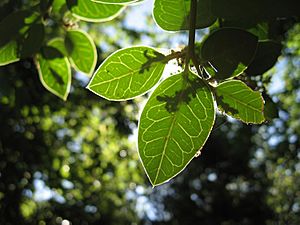Huillipatagua facts for kids
Quick facts for kids Huillipatagua |
|
|---|---|
 |
|
| Conservation status | |
| Scientific classification | |
| Genus: |
Citronella (genus)
|
| Species: |
mucronata
|
Citronella mucronata, also known as the huillipatagua, naranjillo, or Chilean citronella tree, is an evergreen tree. This means it stays green all year round. It is found only in Chile. It grows in the Chilean matorral region, which is in central Chile.
About the Chilean Citronella Tree
This tree can grow up to 10 meters (30 feet) tall. Its trunk can be as wide as 1 meter (3 feet). The bark of the tree is dark gray and feels rough.
The leaves of the Chilean citronella tree are special. They grow one after another along the stem. They feel leathery and can have smooth or slightly toothed edges. Each leaf is shaped like an oval or a longer oval. The tip of the leaf is sharp and ends in a small, pointed tip called a mucro.
The leaves are usually about 4.5 to 6 centimeters long. They are also about 2.5 to 4 centimeters wide. On the underside of the leaves, where the side veins meet the main vein, there are tiny pockets called domatia. The veins on the leaves are yellow. The top side of the leaves is shiny green, and the underside is a lighter green. The leaf stems, called petioles, are quite small.
The flowers of the tree are whitish-yellow. They are hermaphrodite, which means each flower has both male and female parts. These flowers grow in clusters called panicles. These clusters are about 4 to 8 centimeters long. Each flower has a calyx, which is a cup-like part made of 5 small leaves called sepals. It also has a corolla, which is made of 5 separate petals.
After the flowers, the tree produces fruit. The fruit is a round, fleshy fruit called a drupe. It is about 1 to 1.2 centimeters wide. When the fruit is ripe, it turns a purple color.
Where It Lives
The Chilean citronella tree is native to the Mediterranean climate region of Chile. This area is called the Chilean matorral. It grows in different places from Limari Province (at 30°40’S latitude) all the way down to Osorno Province (at 40°30’S latitude). You can find it at elevations from 15 meters up to 1,050 meters above sea level.
It is very common in the Chilean Coastal Range. It is less common further east, in the lower parts of the Andes mountains.
This tree usually grows in sclerophyllous forests. These are forests with trees that have hard, tough leaves. It is often found in a type of forest called Roble–Hualo forest. Here, it can grow alongside other trees like Nothofagus dombeyi and Nothofagus alpina. The exact trees it grows with depend on how far north or south it is.
In coastal areas to the north, it often grows with trees such as Aextoxicon punctatum, Beilschmiedia miersii, Cryptocarya alba, and Schinus latifolia. In the Los Bellotos del Melado National Reserve in the Andes, it grows with Beilschmiedia berteroana, Cryptocarya alba, Nothofagus glauca, and Quillaja saponaria.
Protecting the Tree
Even though the Chilean citronella tree grows across a large area from north to south, it is facing threats. Its natural home is being lost in many places. This is especially true in the Coastal Range. Here, forests are being cut down, and the areas where the trees live are becoming broken up into smaller, separate pieces.
Because of this, groups of these trees are becoming more and more isolated from each other. For example, the longest distance between two groups is 122 kilometers. This makes it harder for the trees to spread and stay healthy.
See also
 In Spanish: Citronella mucronata para niños
In Spanish: Citronella mucronata para niños


